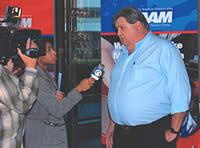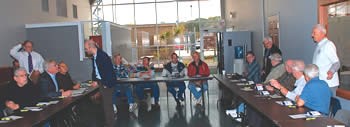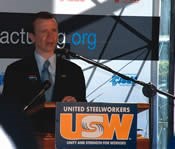Alliance for American Manufacturing
With a mission of keeping American manufacturing strong, this grassroots effort raises awareness on the plight the U.S. is facing and offers tips on how to keep jobs here.
For the past five years, members of the United Steelworkers union and several of its big employers were working hard to combat unfair foreign trade policies. Based on the success of this work, they decided to formalize the relationship and establish it permanently in the spring of 2007—and thus the Alliance for American Manufacturing (AAM) was born with a focus to strengthen manufacturing in the United States.
This non-partisan partnership brings together a select group of America’s leading manufacturers such as U.S. Steel and the United Steelworkers with a mission to “promote creative policy solutions on priorities such as international trade, energy security, health care, retirement security, the environment, green jobs, and other issues of mutual concern,” according to AAM Executive Director Scott Paul.
Taking Action
AAM has 11 employees—five in Washington D.C. and six out in the field all over the country with 25 volunteers who make presentations in their communities based on their expertise on specific issues. Fortunately, Paul notes that the organization has the support of the nation’s largest industrial union, the United Steelworkers, with approximately 850,000 members. “That makes a big difference,” Paul stresses. AAM is funded by the Steelworkers union and about 10 other companies.
Since its inception, AAM has signed up thousands to receive e-mails and attend local events like town hall meetings, which are detailed below. “These events have helped to educate the public and get the message out about what the issues are in manufacturing,” Paul notes.
A Focused Effort
AAM focuses on four areas: research, grassroots advocacy, strategic communications and coalition building.
Research
According to Paul, AAM focuses on mid- to long-term issues that don’t require daily attention on Capitol Hill. “We look at the bigger picture,” Paul explains. “We’ve been able to produce some very detailed, academic-quality reports on a number of the issues facing manufacturing. The first report—called Enforcing the Rules—was launched when we formed. It’s a 90-plus page look at different trade law cases and how domestic industries and the economy in the U.S. have benefited from the application of trade laws. We looked at a number of different cases ranging from steel and ball bearings to things like garlic and raspberries—where domestic producers were facing unfair foreign competition. We also did one on product safety and the challenges we face from China on that subject, energy subsidies in China and their impact on the steel sector.”
The AAM also has worked with a think tank on a series of reports about job losses due to the trade deficit and will be publishing a book that looks at some of the key issues and challenges that face manufacturing. Chapters were written by professors and members of academia and include the challenges of supply chains, trade, foreign subsidies, manufacturing and the national security, social costs of industrialization and what the impact is on communities when jobs leave. “We also look at the ups and downs of particular manufacturing sectors as well as training and skills,” Paul notes. “In addition we are preparing a report on the benefits to manufacturing from investment in infrastructure that will be out in first quarter of 2009.”
Grassroots Advocacy
The second aspect to AAM is grassroots advocacy. “The focus here is the town hall meetings that we have done in cities all over the country,” Paul states. “We held nine of them in fall 2008 alone—in key industrial battleground states. Through these meetings, we share our message and sign people up for our grassroots advocacy. There is no cost to that, our purpose is to bring labor and the community and manufacturers—whether they are large or small, union or non-union—together to focus on the things we have in common. This is one of the most successful aspects of our efforts.”
Strategic Communications
The third leg of AAM is strategic communications. “This term sounds fancy, but what it really means is making sure the media knows what manufacturing is, what the challenges facing manufacturing are, and what the public policy solutions we need are as well,” Paul comments, “because what we have found is a lot of people in the national media have no clue about what manufacturing is. We also try to get beyond the ‘Are you for free trade or are you a protectionist’ mode that a lot of people get into when talking about the trade debate. Our policy is that American manufacturers and workers want to export—and do export—but also are getting hurt by unfair foreign competition, and we have rules of trade and these rules need to be enforced so that we have a level playing field. One can be for that whether one thinks he/she is a free trader or a protectionist.
“The way we do this is through an aggressive earned media outreach campaign where we try to look for opportunities to place manufacturing into stories and we also have done some paid advertising—especially during presidential primaries in places like Ohio, Indiana and Pennsylvania—on China to get the candidates to talk about China,” Paul adds.
Coalition Building
The fourth aspect to AAM’s work is coalition building. “Because our membership is kind of a club (the steel workers and the companies that they do collective bargaining with), we do a lot of outreach to civic groups and to other manufacturers out there to make sure they know we have a lot in common and that we want to work with them, and expand the circle of people that are interested in this issue.”
Conquering Challenges
This year one of AAM’s goals is to expand its reach. “We have been focusing our efforts in the industrial heartland, but manufacturing is important in many other states,” Paul says. “Getting out to the west coast is something we want to do as well as other areas in the country, with these town hall meetings. We also want to reach a younger audience and plan on going to technical colleges and universities that have a technical focus. We want to attract people who want to enter the world of manufacturing and let them know what is at stake.”
Although Paul believes the road ahead is long, he is optimistic about the future of manufacturing. “The set of challenges facing manufacturing are incredible at this time,” he affirms. “The whole issue of competing with China and dealing with unfair trade practices on the one hand, then, the healthcare system that is in place in this country makes it difficult for manufacturers to be competitive if they are providing good healthcare benefits. There also is the energy situation—there will be a debate about energy and climate change in 2009 and how we approach that will make a big difference. Combine those issues with the prevailing view that manufacturing is part of our past—which of course we are trying to change—and it is a difficult atmosphere to get anything done. We have made great progress and we’ve been able to convince people that we do need to focus on manufacturing in this country to rebuild some of the wealth and balance our trade a little bit—and to find good paying jobs that are hard to find in other sectors.”
Related Content
Dynamic Tool Corporation – Creating the Team to Move Moldmaking Into the Future
For 40+ years, Dynamic Tool Corp. has offered precision tooling, emphasizing education, mentoring and innovation. The company is committed to excellence, integrity, safety and customer service, as well as inspiring growth and quality in manufacturing.
Read MoreEditorial Guidelines: Editorial Advisory Board
The Editorial Advisory Board of MoldMaking Technology is made up of authorities with expertise within their respective business, industry, technology and profession. Their role is to advise on timely issues, trends, advances in the field, offer editorial thought and direction, review and comment on specific articles and generally act as a sounding board and a conscience for the publication.
Read MoreMMT Chats: 4 Keys to a Successful Mold-Building Operation: Innovation, Transparency, Accessibility and Relationship
MoldMaking Technology Editorial Director Christina Fuges chats with Steve Michon, co-owner of Zero Tolerance in Clinton Township, Michigan, about the excitement of solving problems, the benefits of showing gratitude, the real struggle with delegation and the importance of staying on top of technology. This episode is brought to you by ISCAR with New Ideas for Machining Intelligently.
Read MoreMold Design Review: The Complete Checklist
Gerardo (Jerry) Miranda III, former global tooling manager for Oakley sunglasses, reshares his complete mold design checklist, an essential part of the product time and cost-to-market process.
Read MoreRead Next
Are You a Moldmaker Considering 3D Printing? Consider the 3D Printing Workshop at NPE2024
Presentations will cover 3D printing for mold tooling, material innovation, product development, bridge production and full-scale, high-volume additive manufacturing.
Read MoreHow to Use Strategic Planning Tools, Data to Manage the Human Side of Business
Q&A with Marion Wells, MMT EAB member and founder of Human Asset Management.
Read More





















